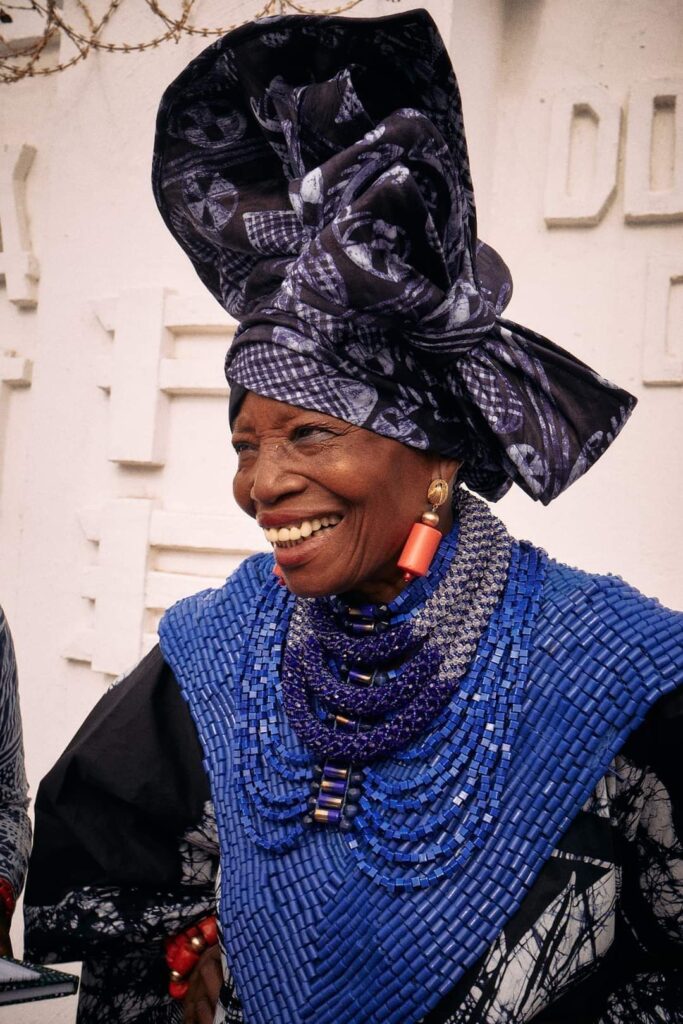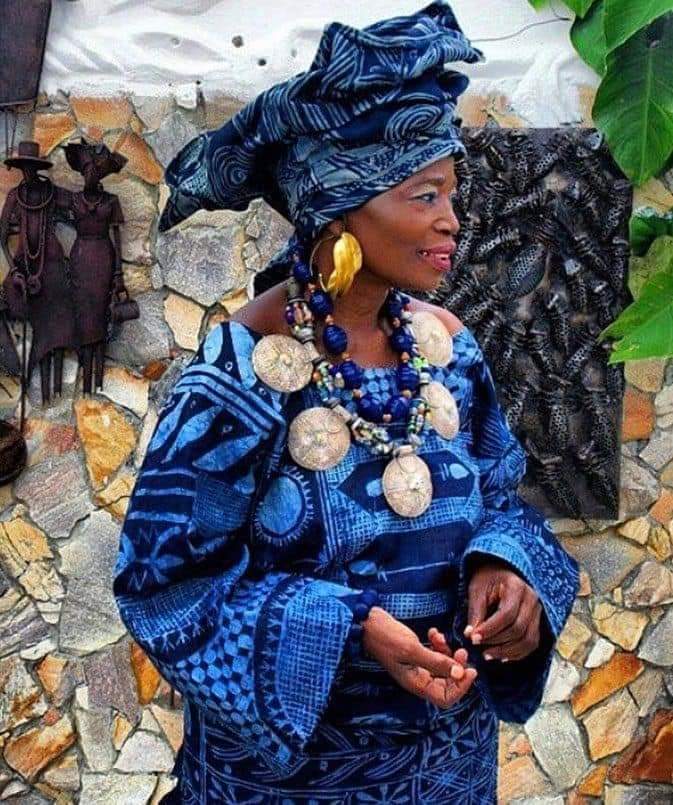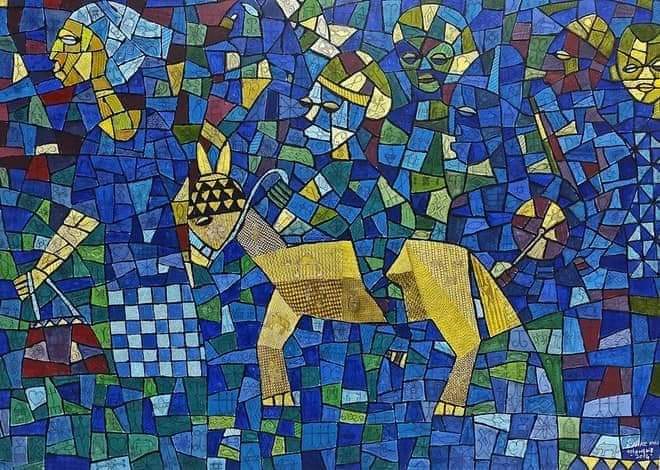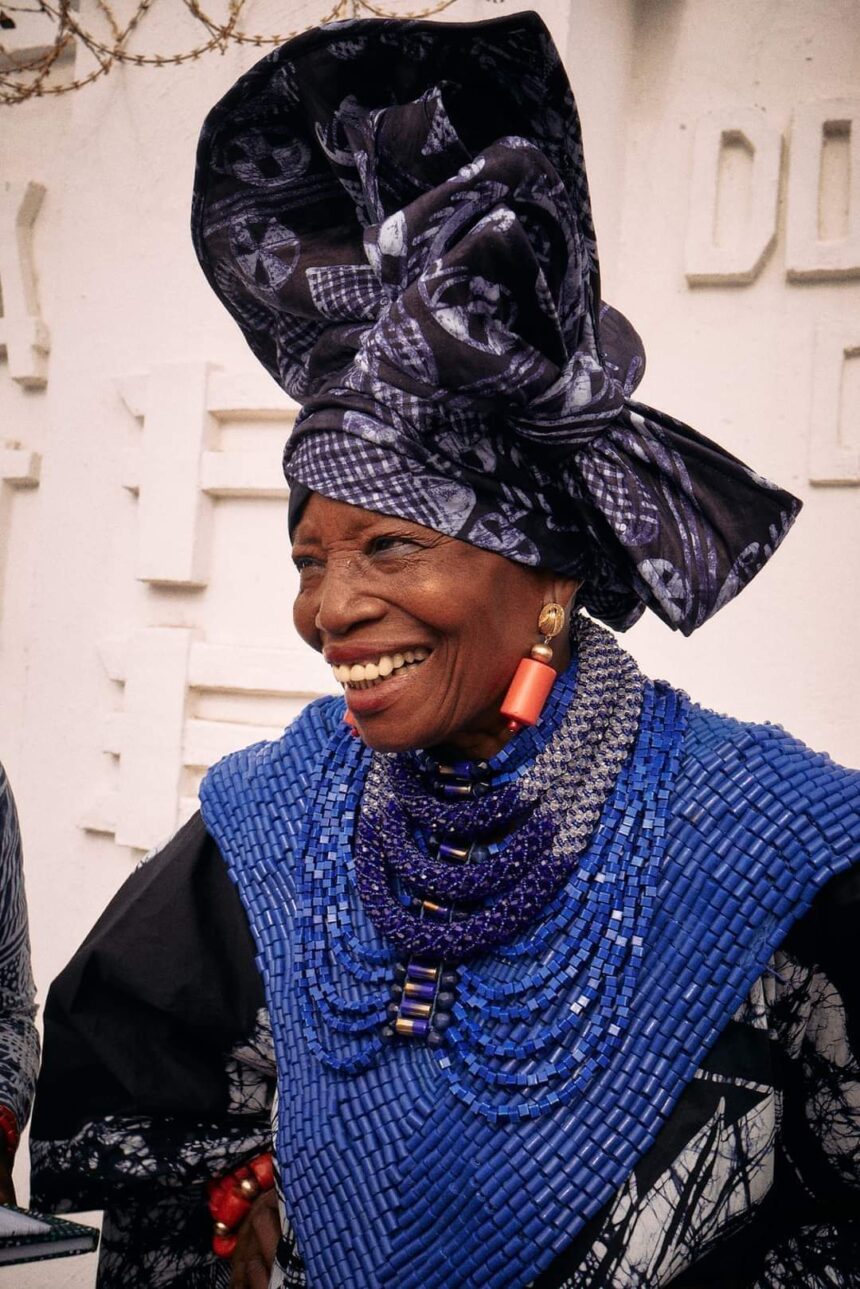Chief Nike̩ Okundaye also known as Nike̩ Okundaye, Nike̩ Twins Seven Seven and Nike̩ Olaniyi, is a Nigerian Yoruba and adire̩ textile designer. She is best known as an artist for her cloth work and embroidery pieces. She was born on 23 May 1951 in Ogidi Kogi State, North Central Nigeria.

Nike Okundaye was brought up amidst the Yoruba traditional weaving and dyeing as practised in her home town. Her parents and great grandmother were musicians and crafts people, who specialized in the areas of cloth weaving, adire making, indigo dyeing and leather.
She learned how to use the loom to produce cloth during the time she lived with her great grandmother Ibito̩la (“Red Woman”). She spent part of her early life in Os̩ogbo, Western Nigeria, modern-day O̩s̩un State. Growing up in Os̩ogbo, which is recognized as a major centre for art and culture in Nigeria, young Nike̩ was exposed to the indigo dyeing and adire production that dominated her informal training.
Over the past twenty years, Nike̩ Okundaye has given workshops on traditional Nigerian textiles to audiences in the United States and Europe. She had her first solo exhibition at the Goethe Institute, Lagos, in 1968. She is the founder and director of four art centres that offer free training to more than 150 young artists in visual, musical and performing arts, comprising more than 7,000 artworks.

Finding that the traditional methods of weaving and dyeing that had been her original inspiration were fading in Nigeria, Nike Okundaye set about launching a revival of this aspect of Nigerian culture, building art centres offering free courses for young Nigerians to learn traditional arts and crafts. As art historian John Peffer states, “One thing shared by many of the latest generation of African artists in the diaspora – those who have been successful on the art circuit – is that their work critiques the very burden of representation that is also the condition of their visibility.”
In her view, the traditional art of Adire̩ E̩le̩ko̩ is only possible because of a specific Nigerian heritage of passing knowledge from one generation to the next. In a video interview published by Nubia Africa, Okundaye states that “school can only teach what they (art students) already know.” According to a CNBC Africa interview, she trained more than 3,000 young Nigerians for free and she continues to help by funding many poor to establish their small businesses and art workshops in different parts of Nigeria.

Nike̩ Okundaye’s adire and batik textiles use visual themes taken from Yoruba history and mythology, as well as visual themes inspired by her own life experiences and dreams. According to Kim Marie Vaz, folklore often intermingles with personal experiences to express disheartening subjects regarding female suffering. Folklore that Nike̩ Okundaye was exposed to through evening stories spoken by the village elder, addressing social issues centred on the female suffrage, in which Nike̩ uses folklore figures to express her concerts on the female suffering through her batiks that portraying the goddess O̩s̩un (i.e. “Mother of Africa”) communicating on ideologies and social norms placed females in constrained positions.
Nike̩ Okundaye strives to improve lives of disadvantaged women in Nigeria through art. She teaches the unique techniques of indigo cloth-dyeing (Adire̩) to rural women at her workshop in South-West Nigeria. She hopes to revive the centuries-old tradition and the lives of these women.
Adire̩ – that which is tied and dyed – is native to the South West region of Nigeria. The freehand dyeing is sometimes known as “Adire̩ E̩le̩ko̩”. “Adire̩” refers to indigo dye, and “E̩le̩ko̩” refers to the boiled cassava, lime, and alum-resist technique used to create patterns. There is a strong tendency to keep dyeing recipes and methods secret from inquisitive outsiders.
Nike̩ Okundaye chooses to continuously reference adire patterns in her artwork because adire is a women’s art, and was taught to her by her mother. Adire̩ pattern motifs were traditionally handed down from mother to daughter, and the designs themselves virtually have not changed in form over time.
Nike̩ Okundaye was featured on CNN International’s African Voices, which features Africa’s most engaging personalities, exploring their lives and passions. Her painting is permanently displayed at the Smithsonian Museum as of 2012, and her work is also part of the collection of the Gallery of African Art and the British Library in London and at Johfrim Art and Design Studio.
She holds the chieftaincy titles of the Yeye O̩ba of Ogidi-Ijumu and the Yeye Tas̩ase of Os̩ogbo.
Nike Okundaye was included in the 2019 show I Am… Contemporary Women Artists of Africa at the Smithsonian’s National Museum of African Art in Washington, D C. In April of the same year, she was conferred with an Honorary Doctorate by Rhodes University during its annual graduation ceremonies.
Personal Life:
Nike̩ Davies Okundaye is mother to two sons and four daughters. She was formerly married to fellow Nigerian artist prince Twins Seven Seven, of late memories, but that marriage ended in divorce. Her children from that marriage are son O̩labayo̩ O̩laniyi, College of Santa Fe graduate, is also an artist. Her second son Folus̩o̩ O̩laniyi, and her first daughter Oluwaseyi Awoyo̩mi, a multifaceted artist. She later married David John Davies, and had her daughters Caroline and Allyson. Her current marriage is to Nigerian Ex Police commissioner, Reuben Okundaye, father to her last child Amen Okundaye.
Nike̩ Okundaye has more than 150 students in Europe and America. She is also a philanthropist.
Honours:
Nike̩ Okundaye is the recipient of honours from numerous esteemed cultural institutions. She has served on the UNESCO Committee of the Intangible Nigerian Heritage Project. She has been honoured as the CEPAN Foundation Art Icon of the year. Nike̩ Okundye has given workshops and lectures at universities world over.
Let’s celebrate our cultural heritage!


